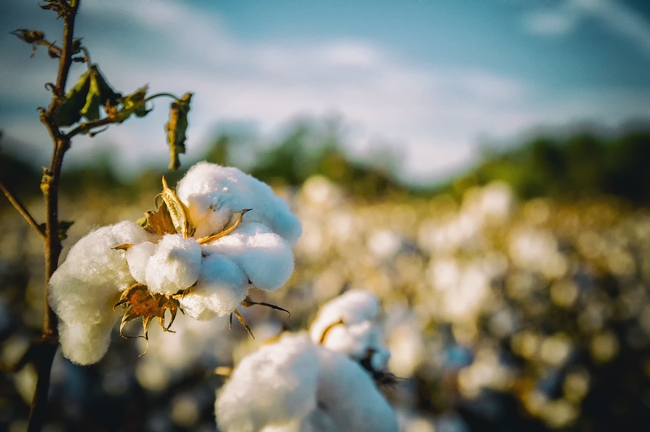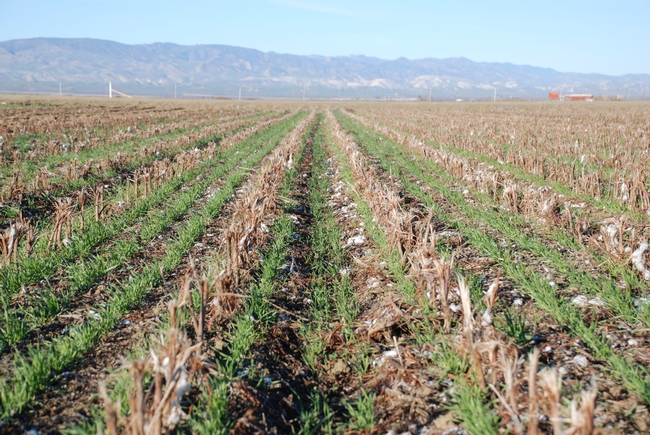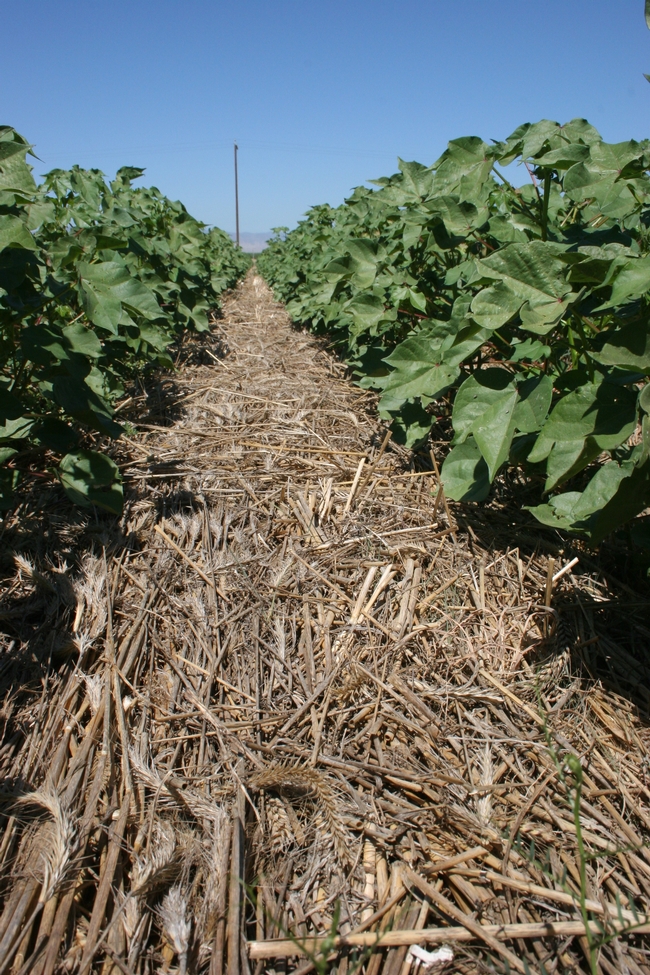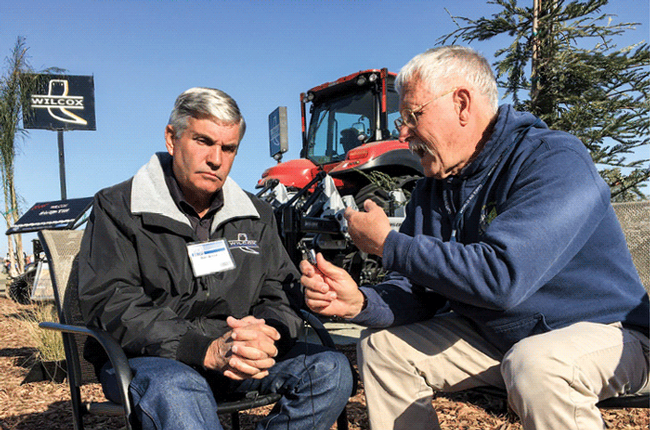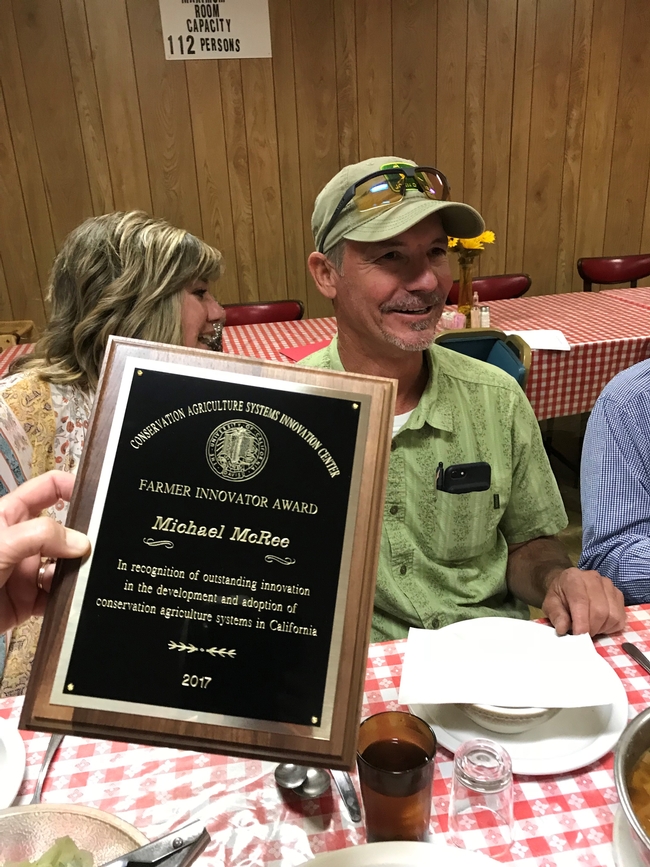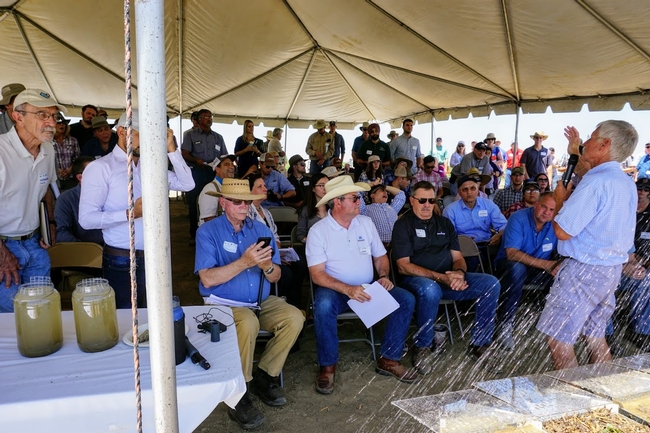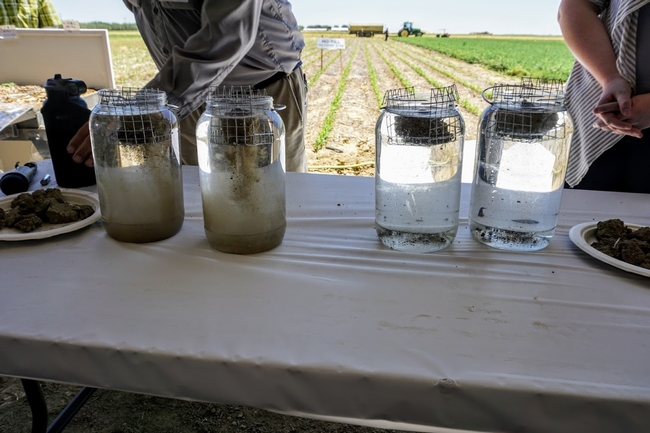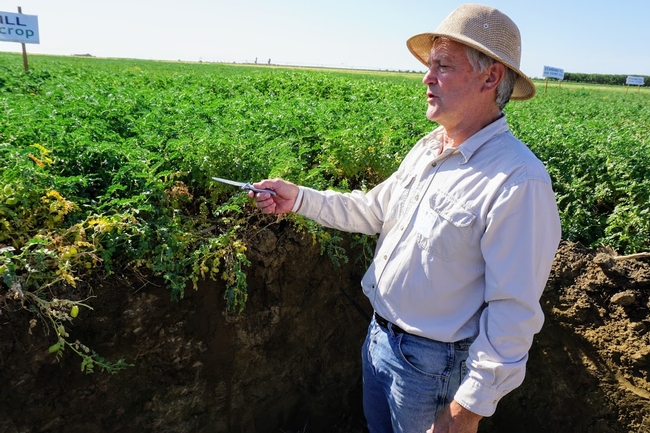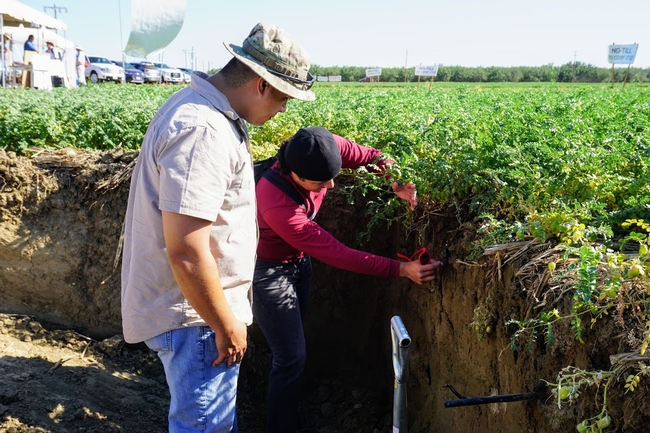Posts Tagged: Conservation Agriculture
Consumers are driving a move to more sustainable cotton farming in California
Consumers who purchase luxury cotton textiles want more than cool, soft, absorbent fabric. Increasingly, they demand clothing made from fiber grown using ecologically sound practices and they're willing to pay for it, said speakers representing the textile industry at a UC Cooperative Extension webinar on Healthy Soils for Healthy Profits.
A recording of the three-hour Sept. 17 webinar – which features clothing manufacturers, farmers and scientists – may be viewed on YouTube at https://youtu.be/rEm8pjbbnaE.
At the beginning of the webinar, UC Cooperative Extension conservation agriculture specialist Jeff Mitchell recalled the tragic 1991 dust storm on the west side of Fresno County, which reduced visibility on Interstate 5, causing a 104-vehicle pile-up that took 17 lives. The devastating accident foreshadowed debates about agriculture's role in reducing dust emissions, he said.
“It turns out that air quality was just the beginning,” Mitchell said. “There is now a whole cascade of expectations that buyers, consumers and the public are demanding of farmers about how food, fiber, feed and fuel crops are actually produced.”
Speakers from non-profit and commercial fashion and fiber organizations said they are anxious to get access to cotton grown using practices that promote soil health and sequester carbon to give their products climate-change mitigation cachet.
“What we envision when we look at the fields is groundcover year-round. Living roots in the soil year-round,” said Rebecca Burgess, director of Fibershed, a California non-profit organization that develops regional and regenerative fiber systems. “No-till or strip-till practices have garnered interest to protect soil from disruption, to avoid breaking up fungal networks. To produce cotton in a system that isn't eroding top soil.”
Wrangler jeans is a clothing brand that has successfully incorporated sustainably produced cotton into its products. The company worked with a group of Tennessee cotton farmers and the Soil Health Institute to produce 100% sustainable cotton jeans and sell them in its Wrangler Rooted Collection. Men's jeans in the collection run about $100 a pair. Ordinary cowboy cut Wrangler jeans range from $39 to $41 a pair.
Burgess said the fashion and textile industry is organizing itself to align with the 1.5-degree pathway, a target set by the Intergovernmental Panel on Climate Change that limits the rise in global average temperature to no more than 1.5 degrees C above pre-industrial levels.
“We want to work with farmers to enhance the ecosystem function of the landscape,” Burgess said. “We need to embed the cost of transitions into the cost of the cotton.”
Growing regenerative cotton in California comes with challenges that farmers are facing head on. Firebaugh farmer John Teixeira this year grew a multi-species cover crop that he terminated with a flail mower rather than a herbicide. He is making compost on the farm and in some parts of the farm spreading 8 to 10 tons per acre.
“We spread it on soil and also on cover crops to digest the cover crop,” Teixeria said. “We're adding bacteria. We would love to have more fungal diversity in the compost, but that's really hard. Fungi don't like to be disturbed. I believe microbes are the future. The key is to keep them alive.”
Gary Martin of Pikalok Farming in Firebaugh was using poultry manure on the farm, until it became prohibitively expensive. He then turned to cover crops and municipal compost to improve water infiltration, soil structure, water retention and increase organic matter. After three years, he added gypsum to improve the soil health.
He found that planting a cover crop without irrigation is a gamble.
“The net value of the cover crop is negative if it doesn't grow (because of a lack of rain),” Martin said. “Composting is more of a sure bet.”
Bowles Farm is experimenting with using a native plant cover crop.
“Native plants are designed to grow when we get moisture, and go away when we don't,” said Bowles Farm executive vice president Derek Azevedo. “It could be a habitat for pollinators.”
The company is also working on writing a carbon plan to map out how much carbon a cotton farm in Merced County can capture. The trial is managed with a multi-species cover crop, strip tillage, untreated seeds, fungal-dominated compost inoculation and a reduction in synthetic nitrogen.
“I can tell you already that the results of that carbon plan are being awaited by one of the brands in the San Luis Obispo area,” Burgess said. “They want to work with that cotton. They are excited to know what this can do for the climate.”
Rebecca Daeschner represented the Los Angeles-based luxury women's wear brand CO (CO-collections.com), which in its current collection sells a ruched cotton top for $725, a cotton button down shirt for $795 and an a short-sleeved cotton dress for $795.
“We're interested in making products that stand the test of time, stay out of landfills, eliminating waste,” Daeschner said.
The company currently sources its high-end materials mainly from Italy, but is interested in transitioning to fabrics that are not only high quality, but also have a reduced environmental footprint. A new line, CO Natural World, focuses on the highest levels of sustainability, organic and regenerative materials, climate-beneficial wools, organic cotton, organic linen and recycled cashmere from garments that can no longer be salvaged.
“To create a garment that goes beyond the very least amount of harm to a garment that actually benefits the planet is the ultimate luxury,” Daeschner said.
The company is part of a network of five clothing brands that are working together to create the California Cotton and Climate Coalition, or C4 Coalition.
“We can do more together than we can do alone to boost the demand for beneficial cotton,” she said. “We are sharing pre-competitive information and pooling our financial resources to overcome existing gaps in the supply chain. And we will share our findings and results to attract new brands to the coalition.”
Calla Rose Ostrander, climate change communicator with the People, Food and Land Foundation, spoke from her home base in Colorado about opportunities for incentives to assist farmers in transitioning to healthy soils practices. She has been working with Maurice Marciano, the founder of Guess Jeans, and his daughter Olivia, who provided funding for part of the Bowles Farm project.
“They want to give back to the cotton community given the legacy of their company,” she said.
Ostrander said there is a network of philanthropic funders who may be interested in supporting the evolution of the cotton production system.
“There's a lot of commitment out there,” Ostrander said. “We're all trying to figure out how to do it and make sure that we can support the farmers in this transition. I'm really glad to see that the emphasis has stayed on supporting the producer and this idea has evolved. It takes time to build things.”
UCCE webinar intends to help farmers raise the value of California cotton
Well-known appellations, powerful marketing and excellent products make California wines very valuable. Could the same be done for California's cotton crop?
California farmers produce high-quality cotton, but currently take in only 62 cents per pound, a price that makes turning a profit challenging. UC Cooperative Extension is working with a team of soil health and fiber sustainability experts to offer an online workshop from 9 a.m. to 12 noon Sept. 17 that will explore ways to increase cotton's value. Speakers will share new soil-building practices and ideas for marketing the crop's sustainable production system to make California cotton more valuable to consumers.
“Buyers and markets are paying attention to sustainability, climate change mitigation and protecting natural resources,” said UC Cooperative Extension cropping systems specialist Jeff Mitchell. “We want to seize the moment for cotton.”
The webinar will start with discussions led by Rebecca Burgess of Fibershed and Cala Rose Ostrander of the People, Land, and Life Foundation about what clothing and textile brands are interested in and what they may be willing to pay in support of healthy soil management systems for California cotton.
Three cotton farmers – Gary Martin of Mendota, John Teixeira of Firebaugh and Cannon Michael of Los Banos – will share their motivations and experiences with cotton soil health management approaches.Cary Crum, a crop consultant with California Ag Solutions, Inc., will discuss striking progress on regenerative ag silage systems with relevance for cotton.
David Lamm, former NRCS National Soil Health Coordinator and now part of the Soil Health Institute in Greensboro, N.C., will share experiences from the Southern U.S. cotton belt to improve soil health.
The program also includes a discussion about long-term soil management research conducted at the UC West Side Research and Extension Center in Five Points by UC Davis doctoral student Geoff Koch and UC Cooperative Extension specialist Jeff Mitchell.
Registration for the general public is $10; registration is free for farmers. To register, visit http://ucanr.edu/sjvcottonwebinar
Webinar sponsors are:
UC Agriculture and Natural Resources, UC Davis Department of Plant Sciences, Conservation Agriculture Systems Innovation Center, California Cotton Ginners and Growers Association, Natural Resources Conservation Service, Soil Health Institutes, Fibershed, California Climate Investments, California Department of Food and Agriculture Healthy Soils Program, Rodale Institute California Organic Center.
For more information contact Jeff Mitchell at jpmitchell@ucdavis.edu, (559) 303-9689.
UC ANR scientist debates conservation tillage practices with industry leader
Alan Wilcox of Wilcox Agri-Products and UC Cooperative Extension specialist Jeff Mitchell debated the challenges and opportunities for increased implementation of conservation tillage practices on California farms during the World Ag Expo in February, reported Alan Stenum in Farm Equipment magazine.
Wilcox said farmers are going to be resistant to anything they suspect will affect yield. Mitchell said creative innovation underway will have a big impact on some of the more challenging crops that are grown in California.
"This is a region where costs are high. The cost of doing business is high, and maximum yields on any crop are important to even break even," Wilcox said. "We're going to be intensely committed to water management and the maximum amount of water."
Mitchell said farmers in other parts of the U.S. started to switch to reduced disturbance no-till systems to conserve water.
"The recognition of the value of that opportunity to reduce soil water evaporation and have more water going through the crops through transpiration hasn't really sunk in here in California in large fashion," Mitchell said.
While Mitchell noted that water is essential to the discussion of conservation agriculture, there are other important aspects to consider.
"Biological cycling of nutrients in the soil, tightening up the system so there are fewer losses, either to the groundwater as some sort of pollution, or improving the overall soil function and nutrition provision capacity of the soil - that's not a small aspect of the overall system, nor are the opportunities for reducing costs," Mitchell said.
Wilcox said he would characterize the argument differently.
"The point is in all of our tillage strategies - and in every situation - we never compromise yield," he said.
Read the complete debate in Farm Equipment magazine.
More information about the use of conservation agriculture practices can be found on the UC Conservation Agriculture Systems Innovation website.
Chowchilla dairy farmer named 2017 Conservation Agriculture Farmer Innovator
“Mike McRee has been extremely willing to share his experiences with others and has graciously hosted numerous public field days at his dairy farm over the years,” said Jeffrey Mitchell, UC Cooperative Extension cropping systems specialist and CASI founder.
The dairy producer, who milks about 2,000 cows at his farm west of Chowchilla, double crops his own dairy forage along with tomatoes and alfalfa crops on about 850 acres. After his pioneering efforts with strip-till – some of the very earliest in the entire San Joaquin Valley – McRee soon found that the conservation agriculture practice saved him time and money as he had anticipated, and yielded other important benefits for his farm as well.
McRee noticed improved water-holding capacity of his soil since working with strip-tillage, as well as increased consistency in the soil's ability to absorb water, mellower soil overall, and more consistent crop stands and yields overall.
Improved soil tilth, increased soil organic matter and earthworms give him consistent yields year to year without extreme highs or lows.
McRee's quest to improve the performance of his silage production systems began back in 2007.
He readily admits that he faced challenges early on.
He tried no-till wheat, but was limited in this effort by hard, compacted soils. Having the right equipment is a key to the whole endeavor, McRee points out.
He has worked with local NRCS partners and the EQIP program, which assists growers with implementation of practices to improve our soil, water and air resources.
Following a great deal of consultation with other growers and experimentation, he developed a very successful strip-tillage system for his silage corps. The change was spurred initially by his interest in reducing the number of times he had to drive a tractor through his fields to save fuel and labor.
He now does fall primary tillage using a Wilcox 7-shank subsoil ripper with a crumbler. Vertical tillage has replaced disc plowing to achieve a smooth seedbed without turning the soil over.
After winter forage is harvested, preparation for corn silage planting begins. McRee explains that he rips the soil down 13 to 14 inches and uses coulters to prepare the seedbed. After pre-irrigation, he uses the Dawn Pluribus strip-till row unit, a tool that preps an eight-inch band of soil for planting. Using GPS, he can run his tractor 6 to 7 mph for this pass.
“With three passes, I can do everything,” McRee said.
“Additionally, McRee has recently installed subsurface drip irrigation that utilizes dairy lagoon water for his silage crops,” said Priscilla Baker, NRCS soil conservationist in Madera. “This project is in partnership with the organization Sustainable Conservation.”
McRee received the award Oct. 13 at the annual meeting of the San Joaquin Valley Resource Conservation Districts held at the Wool Growers' Restaurant in Los Banos.
In 2005, the University of California, NRCS and the Conservation Agriculture Systems Innovation (CASI) Center established the Conservation Agriculture Farmer Innovator Award as a means for providing greater visibility to conservation agriculture pioneers in California. The criteria for this award are demonstrated innovation and leadership in the development, refinement and use of conservation agriculture systems within the California crop production environment.
For more information about conservation agriculture systems, visit http://casi.ucanr.edu.
Better soil boosts farm profit and benefits the planet
Healthy soil does much more than hold plants upright on the surface of the earth. It is a mix of mineral bits and old plant particles teeming with microbes to form a mysterious and complex web of life scientists are just beginning to understand.
While scientists use high technology to study heathy soil – painstakingly counting soil worms and bugs, sequencing the DNA of soil bacteria, for example – some farmers know intuitively whether the soil is healthy just by walking on it.
Scott Park is a first-generation Meridian, Calif., farmer. “When I step on a field and it feels like a road, something is wrong,” he said. “If it feels like a marshmallow or sponge, that's good.”
Park shared his farming experiences with 200 farmers, industry representatives, University of California Cooperative Extension scientists, Fresno State students, news media and others during a half-day UC workshop at the UC West Side Research and Extension Center in Five Points.
“The last 31 years I've been on a mission of building soil,” Park said. “I discovered it by accident and I've made lots of mistakes. But yields trend upwards every year on every crop. Being sensitive to building soil, I'm making a lot of money. And if I'm doing something for the earth, all the better.”
Park said he adds 10 to 15 tons per acre of biomass to his farm every year. He's using less fertilizer, up to 20 percent less water, and even experimenting on the farm by growing a commercial crop with just four inputs: cover crops, water, seed and sun.
“We got high-yielding, good-quality crops,” Park said. “Nobody was more shocked than I am that I got a good crop.”
Researchers are now using the scientific method to figure out the root causes of these empirical observations.
“There's a lot going on in soil,” said Radomir Schmidt, a UC Davis soil microbiologist who spoke at the soil health field day.
A teaspoon of soil has a billion bacteria and six miles of fungal hyphae, the filaments that branch out through the soil from fungi, Schmidt said. The microbes' interaction with living plant roots, the larger pores left by decomposing vegetation and tunneling worms and insects create a system that confers resilience to unforeseen challenges – such as pest pressure, torrential rainfall and plant diseases.
The field day was held under a tent pitched adjacent to an 18-year research trial at the 320-acre facility. The trial compares four farming systems side by side:
- Conventional system, with annual soil tillage and no cover crops.
- Conservation agriculture, with no tilling whatsoever and annual winter cover crops.
- No-till without the cover crop.
- Conventional tilling with a cover crop.
“Take a look over my shoulder to see the difference,” said Jeff Mitchell, UC Cooperative Extension specialist and the study leader. “We've found the cover crops and no-till reduce water needs, cut dust, and lower costs. And there may be more benefits than we realized.”
For example, a graduate student counted the worms, bugs, beetles and other microfauna in soil samples from each of the treatments. There were double the amount in the no-till, cover crop plots compared to the conventional farming system.
UC Cooperative Extension specialist Sloan Rice found that cover crops promote water retention in the soil after rainfall. There is very little water evaporation from the soil surface and water transportation from the cover crop plants in the winter, so little water is lost. Cover crops also promote more water infiltration below three feet.
Healthy soil management also shows promise in confronting global climate change by sequestering carbon in the soil, rather than depleting it.
Manager of Sano Farms in Firebaugh, Jesse Sanchez, was a speaker at the field day. He wasn't surprised by the overflow crowd.
“Farmers are more and more curious. They see some of us using cover crops, and they want to learn more,” Sanchez said. “There has been a swell of interest. I have a tremendous number of visitors every year.”
For more information about soil building, see the UC Conservation Agriculture Systems Innovation website at http://casi.ucanr.edu.


